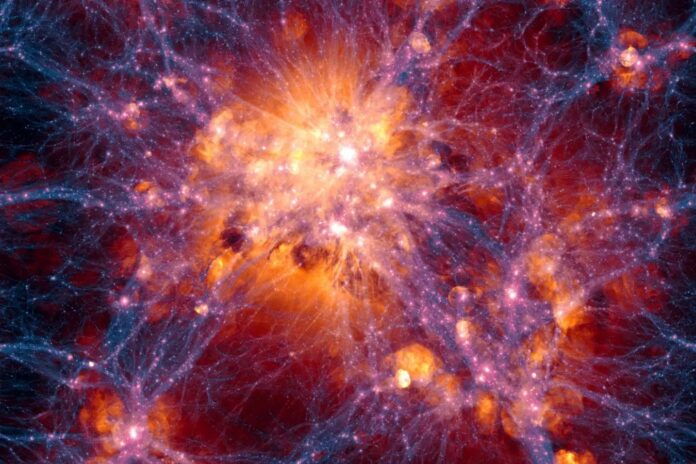Deep in space, about 100 million light-years away, a dwarf galaxy named AGC 727130 is facing a terrifying fate: being starved of the fuel it needs to create new stars. While one side of this galaxy looks normal, its other half reveals an eerie sight—a long stream of gas stretching far beyond its boundaries, seemingly pulled away by an invisible force.
This cosmic strangulation was discovered by astronomers using the Very Large Array, a powerful radio telescope in New Mexico. Their findings point to a culprit lurking within the vast, web-like structure that permeates the universe: the cosmic web itself.
Imagine the cosmos as a giant spiderweb woven from immense filaments of gas and dark matter. Galaxies, like tiny beads strung along these threads, are constantly moving through this ethereal network. Sometimes, as galaxies traverse particularly dense regions of the web—areas where its filaments converge—they encounter intense ram pressure.
This cosmic friction acts like a powerful wind, stripping away the galaxy’s outer layers of gas, which is crucial for star formation. Without fresh fuel, the galaxy effectively “quenches,” ceasing to produce new stars and fading into cosmic darkness.
While astronomers had theorized about this process, directly observing it was incredibly difficult. Ram pressure stripping unfolds gradually over billions of years, making galaxies that have already lost their gas too faint to detect easily. Finding a galaxy caught in the act is akin to witnessing a slow-motion car crash light-years away.
The discovery of AGC 727130 provides crucial evidence for this theory. Its unusual shape suggests it’s being squeezed from the side by multiple filaments of the cosmic web—a phenomenon that’s likely more common than previously thought. This raises intriguing questions about why we see far fewer dwarf galaxies than our current cosmological models predict. Could ram pressure stripping in the vast expanse of the cosmic web be silently extinguishing these smaller galaxies, leaving them undetected?
Future observations with advanced telescopes promise to shed more light on this mystery. Mapping the distribution of gas across the universe in greater detail will help astronomers track down more galaxies like AGC 727130 and understand how widespread this quenching process truly is. Unraveling this cosmic puzzle may hold the key to reconciling our understanding of galaxy formation with what we actually see in the night sky.
































